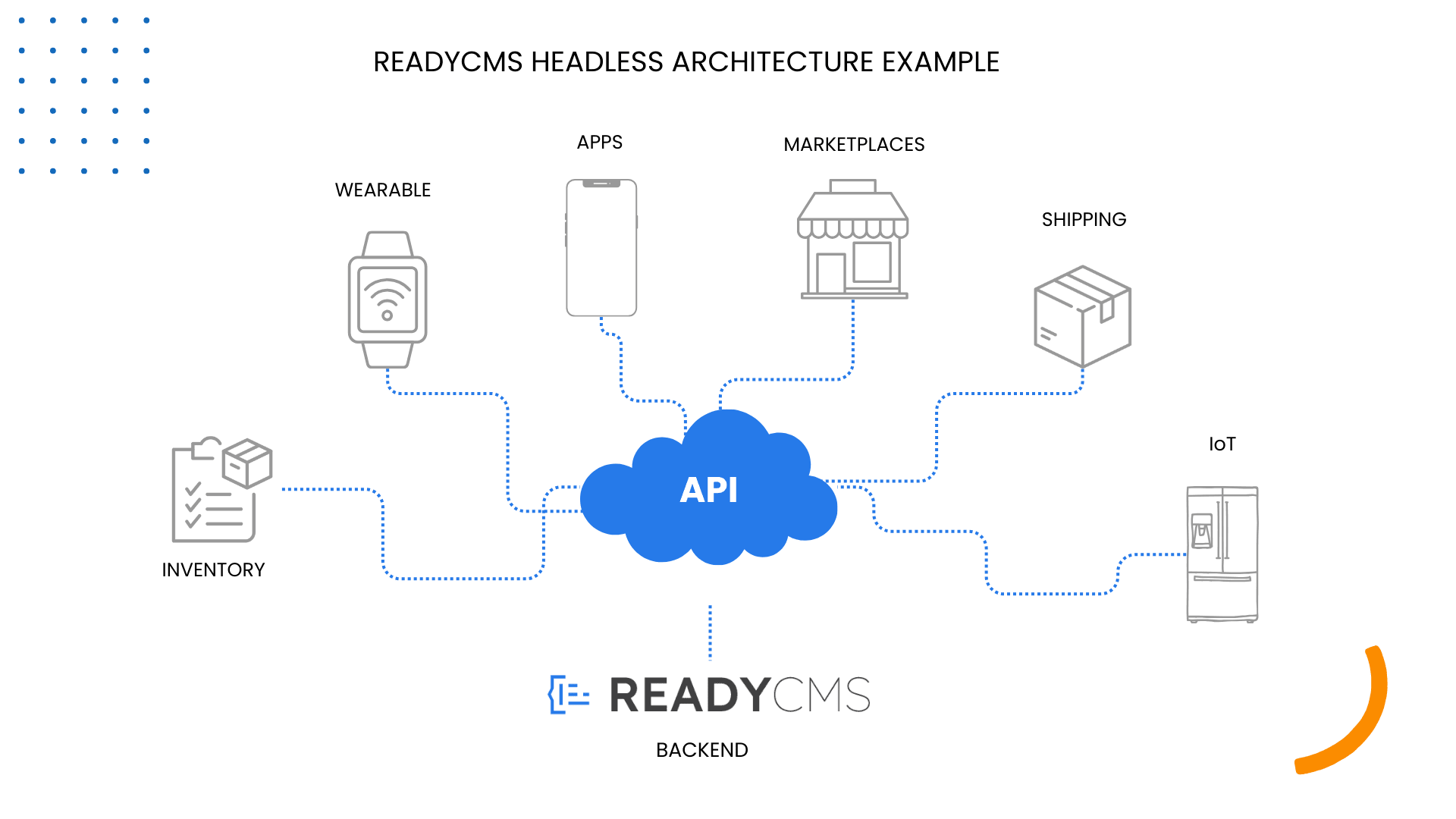What is a headless API
Explore the essence of headless APIs with ReadyCMS. Dive deep into its core characteristics, benefits, and real-world applications. Unravel the future of flexible digital interactions.
In our journey with ReadyCMS, we've often touched upon the concepts of "headless architecture" and its “decoupling" and "flexibility". We've proudly referred to ReadyCMS as a headless CMS, a term that might've left some scratching their heads or diving into the depths of Google for clarity. While we've always championed the benefits, we realized we've never taken the time to provide a comprehensive explanation of what a "headless API" truly is.
It's time to change that! So, let's pull back the curtains and delve deep into understanding the magic behind the term.
The evolution of technology and methodologies has made it possible to decouple the front-end presentation layer of an application from its back-end logic. One of the prominent results of this evolution is the "headless API”.
Understanding the "headless" concept
The term "headless" in software design refers to the removal of the front end or "head" of an application. Thus, a headless API is essentially an API without a predetermined front end. Instead, the API provides the raw data and functionality, allowing developers to use any front-end tool or platform to display the data.

"When we started with ReadyCMS, the term 'headless' was somewhat new. From the get-go, we were captivated by its multitude of advantages. It gave us the flexibility we hadn't experienced before.” — ReadyCMS team
Characteristics of a headless API
- Decoupled architecture: The most salient feature of a headless API is the separation of the backend data operations from the frontend presentation. This allows for independent development and scaling of both.
- Flexibility: Since there's no predefined frontend, developers can choose whatever frontend technology or platform they deem fit, be it web, mobile, IoT devices, or even virtual reality.
Language agnostic: These APIs are generally designed to be language-neutral, meaning they can communicate with any system regardless of the programming language it's written in.
Scalability: Due to the decoupled nature, scaling a headless API is easier. The backend and front end can be scaled independently based on specific needs.
Uniformity and consistency: Regardless of where the data is presented (website, app, smartwatch), the underlying data remains consistent because it's fetched from a single API source.
Future-proof: With no tied front end, when newer platforms or technologies emerge, the back end doesn't need major overhauls. One can simply develop a new frontend for the novel platform.
While typical headless CMS platforms often cater to a developer-centric audience with their complexity, ReadyCMS breaks the mold.
"We understand that a powerful CMS should not only be robust but also accessible. That’s why ReadyCMS is designed with a user-friendly approach, catering to all teams. Whether you’re a developer, a content creator, a marketer, or essentially any user administrator, ReadyCMS makes managing and delivering content seamless and straightforward, without sacrificing the power and flexibility that headless architecture offers." — ReadyCMS team
Examples of application
1. E-commerce platformsA business might have a website, a mobile application, and a voice assistant integration (like Alexa). A headless API can serve product data on all these fronts, ensuring uniformity.
|
2. Content management systems (CMS)Traditional CMSs tightly couple content with presentation. Modern, headless CMS platforms, on the other hand, only deal with the content. This content can be served to a website, a mobile app, or even digital billboards, all through the same API. |
3. Virtual reality & augmented realityVR and AR applications often require real-time data to enrich user experiences. A headless API can serve data to these platforms just as efficiently as it does for a traditional web page. |
4. IoT devicesThink of a smart home system where data about temperature, humidity, and security is fetched and displayed on multiple devices - your smartphone, your smartwatch, and your smart TV. A headless API makes this multi-platform display seamless. |
With businesses rapidly shifting towards digital platforms - from e-commerce stores to widespread IoT devices - the need for a flexible backend system is more prominent than ever. The headless API isn't just a tech buzzword; it's the future of digital interaction.
In conclusion
The headless API marks a significant shift towards a more flexible, scalable, and future-proof approach to application development. It champions the idea that while data remains crucial, the way we choose to present it can remain fluid and ever-adapting. As the digital realm becomes more diverse with myriad devices and platforms, headless APIs will undoubtedly become even more invaluable.
➡️ Interested in experiencing the power of headless CMS? Try ReadyCMS today!
Play the Audio version of this article:
Glossary of terms
- Decoupling: The process of separating two elements that previously worked together. In the context of a headless CMS, it refers to separating the front-end presentation layer from the back-end logic.
Frontend (or Front-end): The part of a website or application users interact with directly. It includes everything the user experiences directly: text colors and styles, images, graphs and tables, buttons, colors, and a navigation menu.
Backend (or Back-end): The part of a website or application that operates behind the scenes. It's responsible for storing and organizing data, and ensuring everything on the front end runs smoothly.
API (Application Programming Interface): A set of tools and protocols that allows different software applications to communicate with each other.
IoT (Internet of Things): Refers to a network of physical objects—“things”—that are embedded with sensors, software, and other technologies to connect and exchange data with other devices and systems over the internet.
Virtual Reality (VR): A simulated experience that can be similar to or completely different from the real world.
Augmented Reality (AR): An interactive experience of a real-world environment where the objects in the real world are enhanced by computer-generated perceptual information.
For Latest News & Update
Tune in to our frequency!
Subscribe to catch all the latest hits, news, and golden classics directly to your inbox